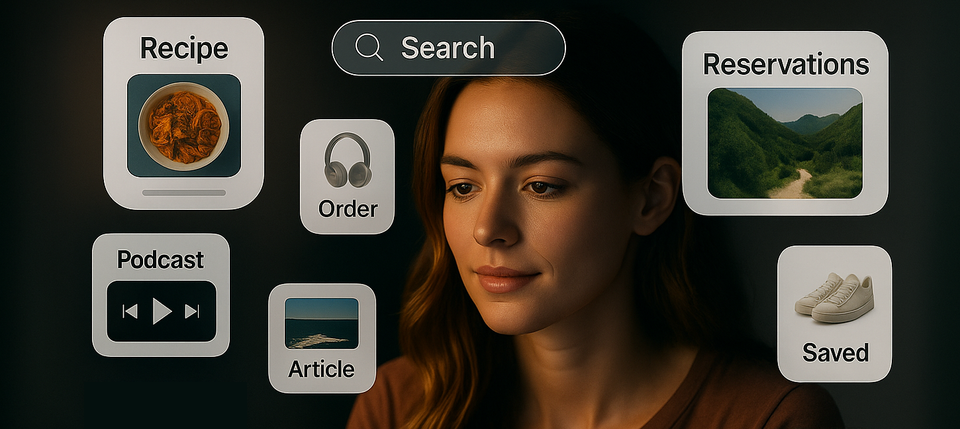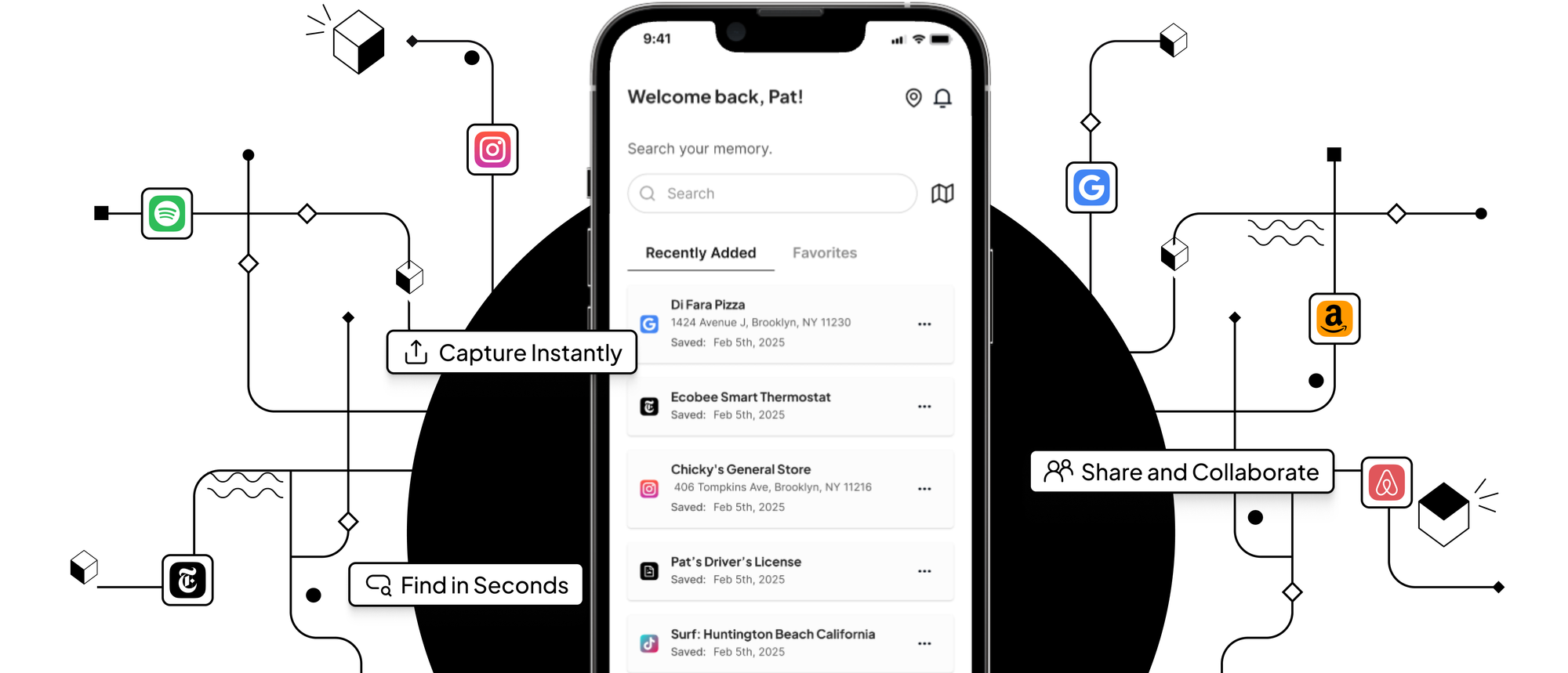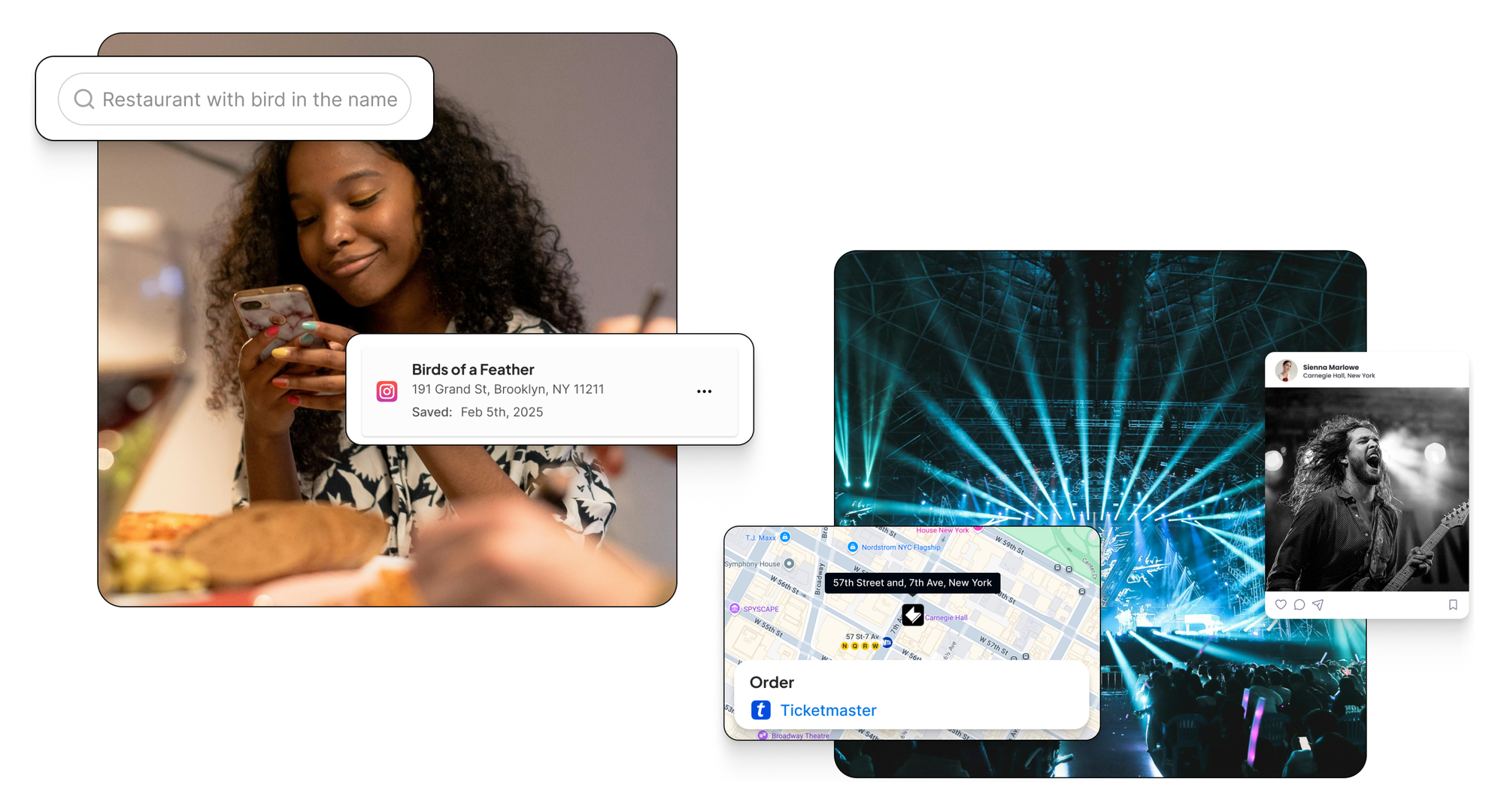The Rise of Recall: A New Way to Save, Search, and Navigate the Internet

Originally Published on LinkedIn on July 3, 2025
TL;DR
- We are drowning in saved content we never find again - screenshots, bookmarks, and notes we rarely revisit, lost across dozens of apps.
- A new category called "recall engines" is emerging to solve this by turning disorganized saves into intelligent, actionable memory systems.
- AI now makes it possible to understand any content type, connect related items, and structure everything for action.
- The best recall engines will succeed on four pillars: flexibility across platforms, contextual intelligence, user privacy, and personal control.
- Nabb is our first step toward that future, a system that will make your tools smarter and your memory useful.
Introduction
We live in an era where we discover more than we can remember. That restaurant your friend mentioned? Buried in a text thread. The perfect recipe? Lost in your camera roll. A bookmarked product? Forgotten until you stumble across it again.
Despite good intentions, what we save often disappears. Disconnected tools make us retrace our steps and repeat research instead of moving forward.
This gap has given rise to a new category: the recall industry.
Recall tools are built to do more than store content. They help you remember what matters, find it when you need it, and follow through, without switching apps or starting over.
The future of the internet will not just be about what you can discover. It will be about what you can recall and act on.
What Is a Recall Engine?
A recall engine helps you remember the content and ideas you have already come across and make use of them when it counts. Think of it as a personal memory layer that spans your digital and physical life. When you finally decide to take that pottery class you have been thinking about, a recall engine instantly surfaces that ceramics article you saved months ago, along with the studio locations and a supplies list.
Whether it is a local event, a travel itinerary, or an article you skimmed weeks ago, a recall engine understands what you actually want to remember. It fills in the gaps to enable easy search, organization, and seamless action when you are ready.
Most tools for storing information, such as notes apps and bookmarks, were built for a simpler internet. They were designed for browsing websites, not for saving short form videos, social media posts, or content discovered through apps.
The core problem is that closed platforms like Instagram, YouTube, and TikTok do not work together. They are designed to hold your attention, not help you carry ideas across time or tools. A product you saw might connect to a conversation you had. A screenshot might relate to a booking you want to make. Without a way to link them, the responsibility falls entirely on you when it is time to take action.
A recall engine collapses that entire workflow into something seamless.
In practice, this means:
- The recipe video you saw last week is now a list of ingredients and steps, ready to cook, no pop-ups or ads in the way.
- That documentary trailer you saved now brings up where to stream it, episode guides, and related titles, ready for movie night.
- That DIY video you stumbled upon becomes a step-by-step project guide with tools, materials, and finishing tips, for when you finally find the time to build it.
- All the restaurants, TikTok spots, and travel recommendations you saved are combined in one shareable trip list, instead of frantically searching through screenshots your first night at the hotel.
A recall engine does not just store what you save, it makes it usable. Your content is already structured and ready when you need it. Your memory becomes a living interface, one that reflects how you think and helps you follow through.
Why Recall Engines Are Possible Now
What makes recall engines viable today is not just changing user behavior. It is that artificial intelligence has finally caught up to solve three critical challenges:
1. Content Understanding Across Formats
Large language models can now interpret and extract meaning from any type of content. These multimodal AI systems can process text, images, and video simultaneously, a capability that only emerged in the last two years. When you save a workout video, AI can automatically identify the number of reps and sets, the equipment being used, and the part of the body being targeted.
2. Cross-Platform Intelligence
AI can understand relationships between disparate pieces of content. It can connect a museum exhibit you saw on Instagram to a calendar reminder you set last month or link a podcast clip to related notes in your writing app. The system automatically builds the connections that people wish already existed.
3. Action-Oriented Processing
Beyond just connecting concepts, AI can now structure and enrich raw content for specific use cases, transforming passive saves into active tools. A saved article becomes a summarized insight with key quotes and a restaurant becomes a reservation opportunity with menu highlights and friend recommendations.
Rather than manually organizing, categorizing, and cross-referencing saved content, AI becomes the memory processor, and the recall engine becomes the interface that makes that memory instantly usable.
The Framework for Effective Recall
These breakthroughs make recall engines possible, but building the right one requires more than just AI capabilities. It must be something people trust, understand, and actually want to use, seamlessly fitting into their existing habits without adding friction.
A true recall engine must work across the fragmented landscape of apps and content formats we actually use, understand the deeper meaning and connections within what you save, stay private enough that you are comfortable saving your most personal interests and ideas, and remain controlled enough that you know exactly what is stored in your digital memory.
Current Tools Are Falling Short
Much like the early search engine era, we are now seeing an explosion of solutions racing to address users' digital memory. Each one takes a different approach (some narrowly focused, some broadly scoped) but none have emerged as the obvious winner:
- Traditional Bookmarking Tools (Pocket, Instapaper, browser bookmarks) excel at saving but fail at surfacing. They create digital graveyards where content goes to be forgotten. Users report saving hundreds of articles they never revisit because there is no intelligent way to surface relevant content when it is actually needed.
- Note-Taking Apps (Notion, Evernote, Obsidian) offer powerful organization but require significant manual effort. Users must actively categorize, tag, and link content. The result is either abandoned systems or tools that work well for power users but fail for mainstream adoption.
- AI Memory Tools (Mem, Recall, various AI assistants) show promise but often lack the cross-platform integration and action-orientation users need. Many focus on capturing everything rather than intelligently filtering what matters, leading to noise rather than signal.
- Platform-Specific Solutions (Pinterest boards, YouTube Watch Later, Twitter bookmarks) work within their ecosystems, but create new silos. Users end up with fragmented memory spread across dozens of platforms with no way to connect related content.
Just as the early 2000s saw dozens of search engines competing to organize the web's information, today we see a similar race to organize personal digital memory. The winners will be those who best balance technical capability with genuine user utility.
The Future of the Recall Industry
Recall engines will start by solving the “Save it For Later” Dilemma, but that is just the beginning. The real transformation happens when your saved content becomes the foundation for a smarter, more connected digital experience.
Imagine you see a hiking trail on Instagram and save it to your recall engine. With current solutions, that is where the story ends, it sits in your saved folder, forgotten. Tomorrow, that same save could automatically add the hiking route to your workout app, block time on your calendar for the weekend, and create a reminder with turn-by-turn directions in your preferred maps app. One save becomes a coordinated action across all your tools.
This progression follows a clear path. First, we need to nail the fundamentals, capturing and organizing everything you want to remember. Once that database exists, recall engines can start making your apps smarter, sharing context, automating workflows, and enabling unified search. Eventually, B2B solutions emerge to solve the same problems in the workplace.
The end state is your recall engine becoming your central hub for the internet. It is where you save everything, search across everything, and take action on everything. You will still use Instagram, your workout app, and maps just like you do today. But now they talk to each other through one intelligent system that turns your scattered digital life into something that actually works for you.
Nabb: The First Step Toward True Recall
Over the past year, I have been building Nabb as our first step toward a platform focused entirely on recall. Not just a place to save things, but a new way of interacting with the internet, personalized to you and connected to the tools you already use.
The Problem We Are Solving
At its core, Nabb solves a fundamental data problem: the content we consume and the information we need to use are buried across disconnected platforms and often hidden behind login screens. Nabb brings structure to that chaos by creating a unified system for remembering and acting on what matters. We are not just another bookmarking tool or note-taking app, we are built from the ground up to unify your digital memory, enrich it with information you need, and make it useful across the tools you already rely on.

How Nabb Works
Our core innovation is transforming the chaotic, disparate data of the internet into a unified, structured system that gets smarter with every piece of content you save:
- Universal Data Unification: We take content from any source and transform it into structured, enriched data. By integrating with best-in-class AI models, we identify not just what something is, but everything you need to know about it.
- Progressive Enrichment: Each saved item becomes a comprehensive data record. A concert mentioned in a friend's text becomes a calendar invite with ticket info. A product in your Instagram feed becomes a direct purchase link with reviews.
- App-Ready Integration: Our goal is not to replace the tools you already use but to make them work better together. Every piece of saved content will eventually become a launching point into your digital ecosystem.

Our Approach to Privacy
From the beginning, Nabb gives users full control over what they save and what stays private. You decide what is public, shared, or just for you. We are working toward advanced privacy models like on-device processing and end-to-end encryption, starting with transparency and user choice.
A Sustainable Business Model
We believe recall should be free and accessible. Our model is built around enhancing user experience rather than exploiting it, through user-controlled advertising that enhances what you have captured, third-party app integrations, and enterprise solutions for teams.
This is just the beginning. We are building with ambition and humility, open to feedback, and committed to creating something that truly helps people take control of their digital lives.
The Recall Revolution
The dawn of the internet gave us infinite information. Search engines gave us the ability to find anything. Social platforms gave us the ability to connect with anyone.
Recall engines will give us the ability to remember everything that matters and act on it instantly.
This represents a fundamental shift from consumption to curation, from discovery to memory, from information overload to personal intelligence. The question is not whether recall engines will emerge. It is who will build them responsibly, and how quickly they will become as essential as search engines are today.
If you want to be among the first to try Nabb, join our waitlist or reach out directly at pat@nabb.app. We are looking for early users who share our vision of a more organized, actionable internet.
